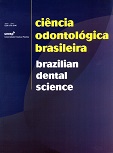Efeitos da terapia de reposição hormonal com raloxifeno e risedronato na reparação óssea de ratas com osteopenia
DOI:
https://doi.org/10.14295/bds.2007.v10i3.295Abstract
O objetivo do estudo foi de analisar radiograficamente os efeitos do risedronato e do cloridrato de raloxifeno na reparação óssea de ratas osteopênicas. Utilizou-se cinqüenta ratas divididas em cinco grupos de 10 animais cada: (I) SHAM, (II) ovariectomizadas (OVZ), (III) OVZ e tratadas com risedronato 1mg/kg/dia, (IV) OVZ e tratadas com raloxifeno 1mg/ kg/dia e (V) OVZ e tratadas com raloxifeno 3mg/kg/dia . Após trinta dias da ovariectomia executaram-se lesões ósseas de 3 mm de ∅?nas tíbias direitas. Após 7 e 28 dias de tratamento as ratas foram sacrificadas e as tíbias avaliadas quanto à densidade radiográfica da região de reparação do defeito ósseo por meio do sistema digital RVG Trophy e programa Image Tool 2.03. Os dados da análise da densidade óptica radiográfica foram submetidos à ANOVA e Teste de Tukey (p≤0,05). Os resultados mostraram que aos 28 dias os grupos I e V apresentaram valores de densidade mineral óssea superiores e estatisticamente significantes em relação aos grupos II e IV e semelhantes ao grupo III. Além disso, o grupo III obteve densidade mineral óssea estatísticamente superior ao grupo II e semelhante ao grupo IV. Concluiu-se que o raloxifeno na dose de 3mg/kg/dia e o risedronato na dose de 1mg/kg/dia, aceleraram o processo de reparação óssea, apresentando efeito semelhante ao grupo SHAM. O efeito do raloxifeno na reparação óssea mostrou-se dose-dependente.Downloads
Downloads
Published
How to Cite
Issue
Section
License
Brazilian Dental Science uses the Creative Commons (CC-BY 4.0) license, thus preserving the integrity of articles in an open access environment. The journal allows the author to retain publishing rights without restrictions.
=================




























